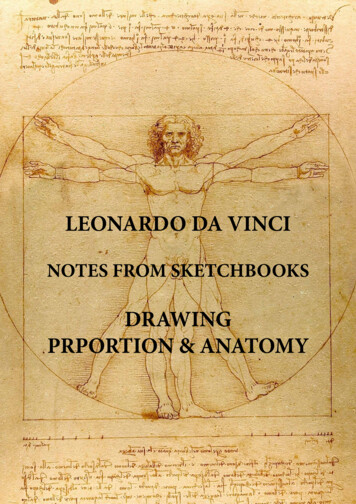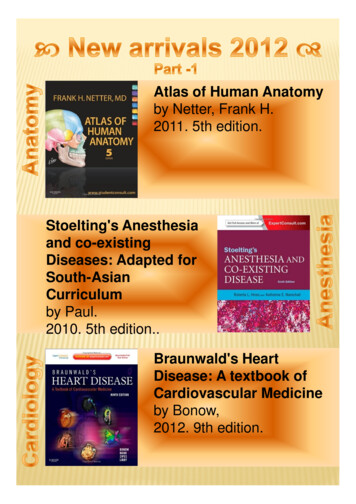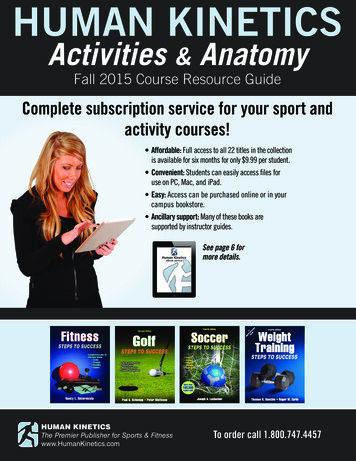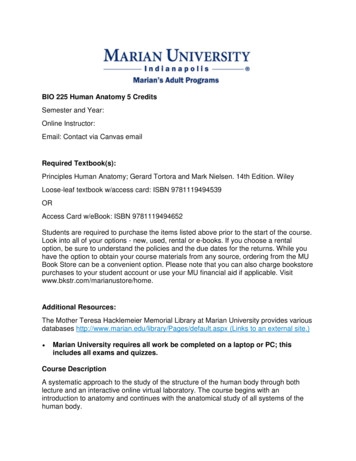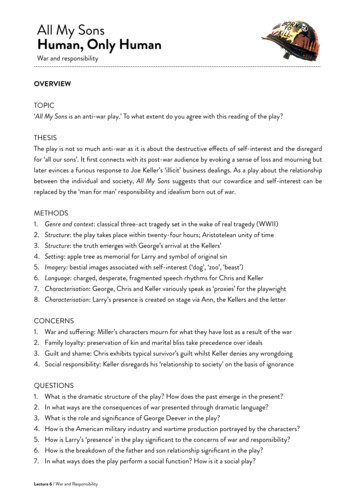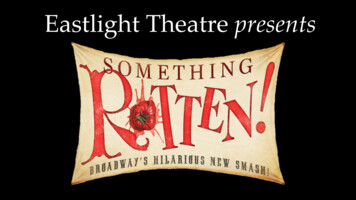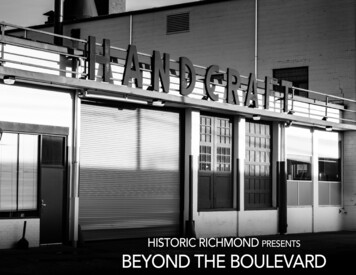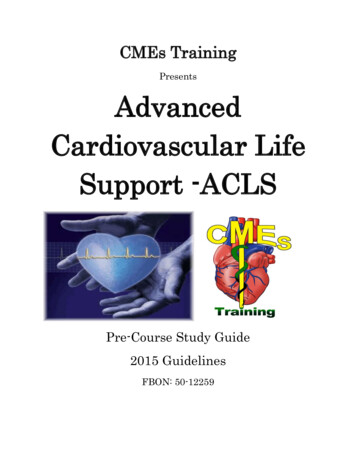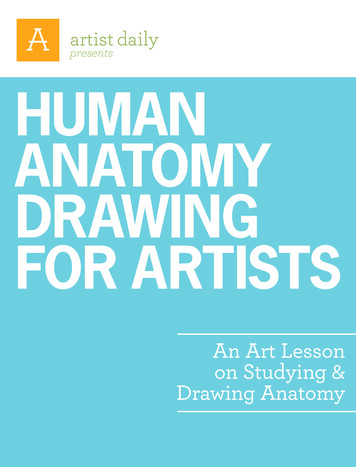
Transcription
presentsHumananatomydrawingfor artistsAn Art Lessonon Studying &Drawing Anatomy
Human anatomydrawing for artistsStanding Female Nudeby Rudolf Hirth du Frêne, graphitewith white heightening. CollectionKunstmuseum Basel, Basel,Switzerland.When studying anatomy, try tovisualize the basic form conceptsunderlying the figure built upontapering cylinders as in the limbs;boxy tubular forms as in the pelvisand chest; and spheres as in thehead, breasts, and many othersmaller sub-forms that are oftencombination half-spheres andhalf-cylinders, such as the biceps,stomach mass, or buttocks.How to StudyanatomyKnowledge of the human body can be an invaluable tool for artists—as long as the study of anatomy is approached in the right way.by Dan GhenoThis content has been abridged from an original article written by Dan Gheno. This premium has been published by Interweave Press, 201 E. Fourth St., Loveland, CO 80537-5655; (970) 669-7672. Copyright 2011 by Interweave Press, a division of Aspire Media, all rights reserved. The contents of this publication may not be reproduced either in whole or in part without consent of the copyright owner.2www.artistdaily.com
Human anatomydrawing for artistsMdiving in and out of one another. Determined toany artists debate thepersevere, I began the only way I then knew how:question, “Why shouldlearning one muscle at a time, starting with ayou study anatomy?” Butneck muscle called the sternocleidomastoid.it’s less often that youIt was only years later that I realized there was anhear an equally imporeasier and better way to study anatomy. This articletant question: “How dowill explain in-depth how you can streamline youryou study anatomy?”studies into a more rewarding and manageable proFor me, answering the question “why” is easy.cess by utilizing the right resources and by first conWhen I was 10 years old, I could see that my drawcentrating on the bones rather than spending hoursings of people were flat and formless, with armsmemorizing the names and shapes of muscles.and legs that looked like rubber. I realized I needed to study anatomy if I wanted to givemy drawings any kind of structureSeated Man,Leaning Backwardand volume. But when I took my firstby Anthony van Dyck,look at the anatomical charts, I staredca. 1618, black charcoalincredulously at the complex mass ofon woven paper, 9¼x 107 8. CollectionMany art teachers evangelize againstmuscles that comprised the humanMuseum Boijmans Vanthe study of anatomy. I can certainlybody, and I nearly gave up. None ofBeuningen, Rotterdam,the Netherlands.understand their fear; quite a few stuthe muscles were easily definable orThe flat rhomboidsdents who have studied anatomy endconfined to an individual body part.muscle starts at the spineup putting the cart before the horse byInstead, they seemed to incoherentlyand attaches to the innerborder of the scapula.drawing their preconceptions of thecriss-cross bones, with muscle massesThe Purpose ofArtistic Anatomy3www.artistdaily.com
Human anatomydrawing for artistsStasisby Dan Gheno,2003, coloredpencil and whitecharcoal on tonedpaper, 24 x 18.Collection the artist.4www.artistdaily.com
Human anatomydrawing for artistsfigure’s anatomy instead of the visual reality infront of them. But this is a limitation of the studentwho hasn’t studied enough, not an inevitable resultof the study of anatomy itself.As the great anatomy teacher Robert BeverlyHale often noted, the study of anatomy is the “scientific” side of art, meant as a tool to help youunderstand the model’s volumetric nature andfind subtle visual details you might otherwisemiss. This means you should dedicate a certainamount of time solely for your anatomical investigations so that your “scientific” endeavors don’tpollute your artistic efforts. Your anatomical efforts, though, should always include drawing thehuman figure from life, which gives you something compellingly real to keep you motivated andto judge your studies against.A brief study of form concepts will help simplify your initial efforts to understand anatomy.Unsophisticated as it may sound, all your knowledge of anatomy will do you no good if you don’tunderstand how each limb and digit can be visualized as a tapering cylinder; the head as a type ofcornered sphere; and the torso as a blocky, tubularform. With this basic understanding as a foundation, you can then proceed into a more intensivestudy of the bones and their joint systems, followed by the individual muscles along with theirorigins and insertions. Your studies can thengrow to encompass superficial structures such asf lesh, wrinkles, and veins.Ultimately, the idea is to learn anatomy so wellthat it becomes part of your subconscious so thatyou don’t have to think about it while you drawthe model. In the preface to his book, A Handbookof Anatomy for Art Students, Arthur Thompsonproudly quotes one of his pupils who said, “Thefirst thing I did after passing my exam was to burnyour book.” Incorporating anatomical knowledgeinto your art should become a fluid, intuitive act,rather than a focal point that detracts from yourcreative process.5www.artistdaily.comThe Right ResourcesAs we shall see, there are many resourcesavailable to help you pursue your studies,including books, videos, lectures, and sculptural approaches. And of course, there’s alsothe way many Old Masters learned anatomy—through dissections.BooksFor many artists studying on their own,their only anatomy resource may be a singlebook. But anatomy is a complex subject—one book can’t cover it all. Therefore, readall the books you can lay your hands on,whether you buy them, borrow them fromthe library, or download them free off theStanding MaleNude Seen FromBehindby John SingerSargent, ca.1890–1915, charcoalon paper, 247 16 x1811 16. Harvard ArtMuseums, Cambridge,Massachusetts.Anatomical formsimpart rhythm to thehuman figure in the waythey interlock with eachother. For instance,observe how the spineslips into the pelvis atthe sacrum; how thegluteus maximus, orlower buttocks, overlaponto the upper leg;and how the tendon ofthe hamstring musclesspan the upper andlower portions of thenear leg.
Human anatomydrawing for artistsA Bear’s Leg Dissectedby Leonardo da Vinci, ca. 1490, metalpointand ink with white heightening on pale blue-grayprepared paper, 63 8 x 53 8. The Royal Collection,Windsor, England.If you want to understand the human machine, ithelps to study animal anatomy; and if you want todraw animals, it’s crucial to know human anatomy.When dissected, there are many striking parallelsbetween human and animal forms, even whencomparing humans to non-primate species —especially bears. Leonardo greatly valued the studyof comparative anatomy, filling many pages of hisnotebooks with drawings of dissected animal forms.internet. Once you examine differenttexts, you’ll often find that many booksthat seem poorly illustrated—such asRichard G. Hatton’s Figure Drawing orJack Hamm’s Drawing the Head and Figure—are fountainheads of information.Conversely, some well-known guidescan actually be misleading to someonejust beginning to study the subject.However, every book has at least someuseful information not found in theothers.You may also find that many anatomy books contradict one another.Because of this, it’s important to haveat least one book that you rely upon asyour ultimate reference—the book you6www.artistdaily.comgo to for the final answer. Two anatomybooks serve this purpose for me: Artistic Anatomy by Dr. Paul Richer and Human Anatomy for Artists: The Elements ofForm by Eliot Goldfinger. My copies arenow tattered and worn, with tape andpost-it notes sticking over the sides sothat I can quickly find the pages I usemost often.Whether you are an advanced artistor a beginner, I think you’ll find thatmost anatomy books are not inviting toread word by word—especially booksthat are heavy on detailed diagrams.When you first open an anatomy book,it’s a good idea to do some rough sketches of the muscles from the diagrams toacquire a taste for their shape and get acquainted with the subject. Then, look atthe diagrams again, and loosely sketchthe areas of the skeleton concerned withthe movements of these muscles in anabbreviated manner. Finally, using tracing paper, try layering the muscles ontop of the bones, paying special attention to their origins and insertions.When studying individual musclesthis way, you usually need to draw atleast two bones to support the muscle. Amuscle’s sole purpose is to contract andmove the body part, and a muscle thatstarts on one bone can only cause an action if it reaches past a joint to anotherbone. For instance, the biceps musclestarts within the torso on the shoulderblade, passes over the shoulder joint,crosses the elbow joint system, andinserts into the lower arm. When thismuscle contracts, it can help lift the upper arm, bend the lower arm, and eventwist the wrist inward under certainconditions. Consequently, to better understand the full function of the biceps
Human anatomydrawing for artistsIn Actionby Dan Gheno,2007, coloredpencil andwhite charcoalon tonedpaper, 24 x18. Collectionthe artist.7www.artistdaily.com
Human anatomydrawing for artistsmuscle, you will need to draw not only the bone itprimarily covers (the humerus, in the upper arm)but also the other bones that participate in its action: the shoulder blade, the collarbone, and thebones of the lower arm, called the ulna and radius.Even though it’s nearly impossible for mostartists to read an anatomy book sequentially fromcover to cover, you shouldn’t ignore the wordscompletely. As an artist trying to understand thestructure of the human body’s forms, you are morelikely to retain and absorb the information if yourefer to the text as you draw from the diagrams,consciously asking yourself what function eachmuscle or muscle group serves, where it begins,and where it ends.I don’t advocate memorizing all the musclenames, but knowing them can help retention, asmany of the names refer to the muscles’ shapes,functions, origins, and insertions. Knowing thisnomenclature will help you remember the essential characteristics for each muscle. Even as a child,I couldn’t forget the importance or complicatedvisual shape of the sternocleidomastoid, becauseits equally complicated name refers to the position8www.artistdaily.comaboveMale Nude From the Backby Egon Schiele, 1910, watercolor and charcoal, 18 x 12. Private collection.With an anatomy book by your side, you will see that Schiele depicts several keyanatomical landmarks in this expressive drawing, including the vertebral column, thesurrounding postlike spinal muscles, the trapezius, the rhomboids, the triangularsacrum in the pelvis, and the iliac crest, among many other visually important details.top leftSelf-Portrait With Arm Twisting Above Headby Egon Schiele, 1910, watercolor and charcoal,17¾ x 12½. Private collection.There are many ways to put the knowledge of anatomy to artistic use. Some artistsuse it to help them find subtlety of form and value shapes, and other artists, such asSchiele, use their understanding of muscles and bones for expressive purposes.
Human anatomydrawing for artistsTransparent Front and Back Viewby Jean-Baptiste Leveille, 1849,lithograph. From The Anatomy of the External Forms of Man byDr. Julien Fau.When analyzing anatomy on the living figure, try visualizing thebones underneath as if the superficial forms were transparent.A helpful exercise is to first draw the figure in a simple, flatsilhouette form. Then, try to superimpose your understanding ofthe bones within. Follow this with a layer of muscles, noting wheretheir origins and insertions occur on the underlying bones.of its origins at the sternum (sterno) and clavicle(cleido) and to its distant insertion behind the earat the mastoid process.Life SketchingIf you’re like most people, you may reach yourfrustration level rather quickly when drawing fromanatomical charts, and you might find that there isa limit to how much information you can absorb inthis way. To extend your motivation and energy levels, attend a sketch group or figure-drawing classas often as possible. Buy a lightweight, portableanatomy book, such as Edmond J. Farris’ Art Students’ Anatomy, so that you can bring it with you forreference while you sketch from life.It’s extremely important to trust your eye instead of imposing your knowledge of anatomy onthe model. But turn to your anatomy book as soonas you see a shape or lump on the model that defiesthe limits of your anatomical knowledge, and tryto find the muscle or bone causing that shape. Although studying anatomy through books alone canbecome tedious and seem like an artificial process,using the model in front of you in this way willhelp you to build a list of compelling questions thatan anatomy book can help answer.It’s not all about bones and muscles. Skin, fat, veins,the model’s age, and the influences of the environment all have an effect on the muscles underneathand are an essential element of your studies. Use lifedrawing sessions to drill yourself. Look at the modelfor superficial anatomy, and question yourself onthe boney and muscular landmarks below the skin.9www.artistdaily.com
Human anatomydrawing for artistsAnatomy ClassesMost people wouldn’t try to learn a complex subjectsuch algebra, physics, or psychology from booksalone. The same is true for the subject of artistic anatomy. After drawing from anatomy books for a coupleof months, you may find it very helpful to take a classfrom someone who can demonstrate the structure ofhuman anatomy in person and who is available to answer questions as you go along. It’s especially helpfulif the lecture class is combined with drawing fromthe model, as the teacher can then look at your workand double-check your anatomical accuracy.Sculptural ÉcorchésThere is a limit to how far two-dimensionaldiagrams can take you on your journey to understand the human form. To help combinethe tactile
Jack Hamm’s Drawing the Head and Fig-ure—are fountainheads of information. Conversely, some well-known guides can actually be misleading to someone just beginning to study the subject. However, every book has at least some useful information not found in the others. You may also find that many anat- omy books contradict one another. Because of this, it’s important to have at least one .
